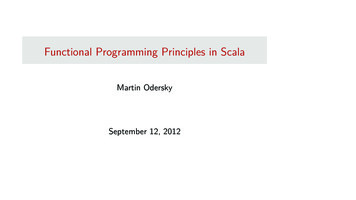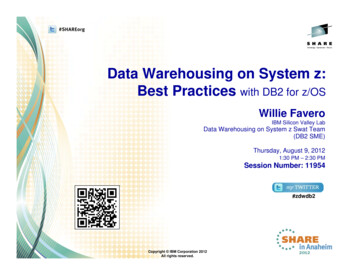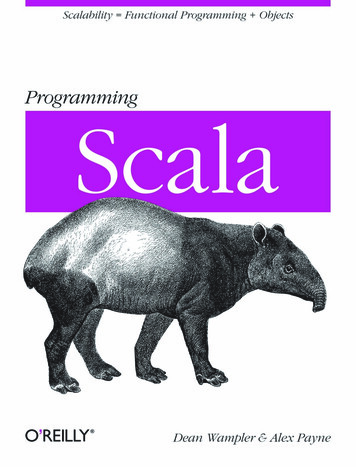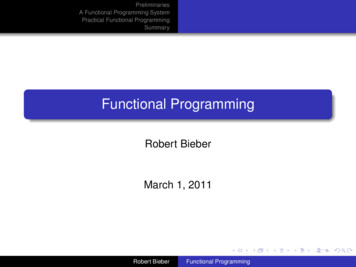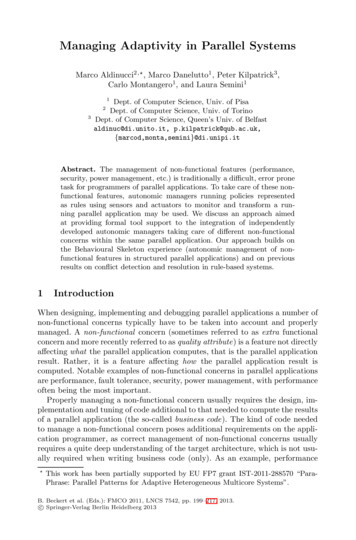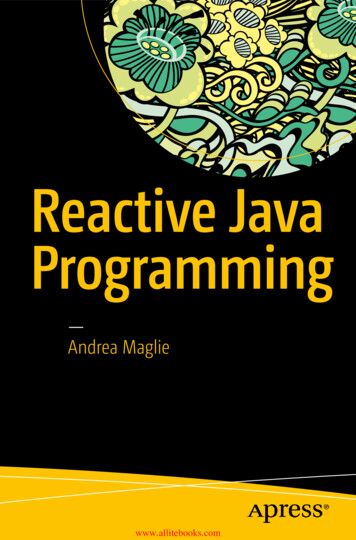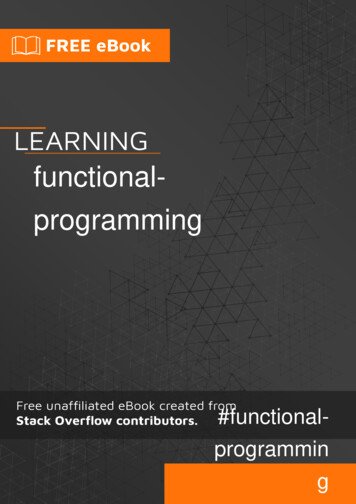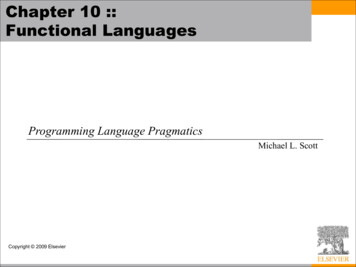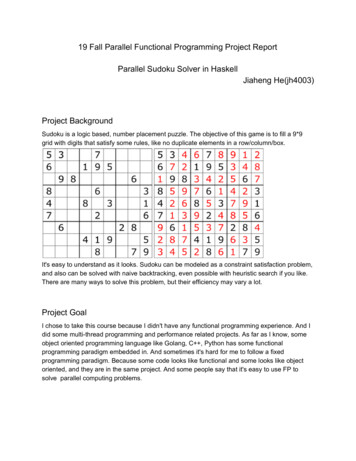
Transcription
19 Fall Parallel Functional Programming Project ReportParallel Sudoku Solver in HaskellJiaheng He(jh4003)Project BackgroundSudoku is a logic based, number placement puzzle. The objective of this game is to fill a 9*9grid with digits that satisfy some rules, like no duplicate elements in a row/column/box.It's easy to understand as it looks. Sudoku can be modeled as a constraint satisfaction problem,and also can be solved with naive backtracking, even possible with heuristic search if you like.There are many ways to solve this problem, but their efficiency may vary a lot.Project GoalI chose to take this course because I didn't have any functional programming experience. And Idid some multi-thread programming and performance related projects. As far as I know, someobject oriented programming language like Golang, C , Python has some functionalprogramming paradigm embedded in. And sometimes it's hard for me to follow a fixedprogramming paradigm. Because some code looks like functional and some looks like objectoriented, and they are in the same project. And some people say that it's easy to use FP tosolve parallel computing problems.
So I'd like to take this chance to learn:1. How to write parallel and concurrency code(example question: I've read some postsabout add -threaded when compile may make the program faster, but there isn't anycode start a new thread)2. Pros and Cons of FP(efficiency, maybe easy to code for parallel and concurrency?)3. When to use FP? What kind of projects is more suitable for FP?Instead of choosing a hard problem to solve, I'd like to take this simple problem and try to findout the answers of these three problems. So that I can focus more on the language rather thanthe problem.Sudoku solver algorithms1. Dancing LinksDancing links is a data structure invented by Donald Kruth for his project Algorithm X,which is a backtracking solution for the exact cover problems. And N Queens problemand Sudoku are both exact cover problems. On Hackage I found a package called"exact-cover" aiming to solve exact cover problem. But learning to use a packagewouldn't help me know more about haskell efficiency, and I better know how to use thelanguage first before I implement an algorithm with it. Otherwise, I can only implementthe algorithm as the pseudo-code describes and it's hard for me to optimize it and makefull use of syntax sugar from Haskell.2. Naive backtrackingTo me, this is still a good point to start with. I wouldn't say I can write efficientbacktracking code in Haskell. So it's a good point for me to start and improve my code.Dancing links can count as a backtracking algorithm, and it's also a search algorithm.How you make the next guess and prune unnecessary branch can largely affect therunning time of your code.3. Constraint Satisfaction ProblemCSP is also a backtracking problem, on finite domains, it's typically solved using a formof search(backtracking, constraint propagation). In Sudoku, you may have multipleoptions for a black cell, and your choice for this cell will definitely affect constraints set ofother cells. Constraint propagation is a method that prune unnecessary branches andreduce search time based on your choice on current cell.
CodeI managed the project with the help of stack. A simple usage of the code is in "README.md",and source code is in "app/Main.hs" and "src/Sudoku.hs", test cases are in "test/Spec.hs", and Iran multi-core test with input from "easy.txt", "hard.txt".Main.hsmodule Main whereimport Control.Applicativeimport Control.Monadimport System.Environmentimport System.IOimport Sudoku ( solve )-- Solve Sudoku puzzles from a file of Sudoku stringsmain do[f] - getArgslines readFile f mapM (mapM putStrLn . solve)Sudoku.hsmodule Sudoku( solve ) whereimport Data.Listimport Data.Chartype Cell Maybe Inttype Row a [a]type Grid a [ Row a]type Options [ Cell ]boxes :: Grid a - Grid aboxes deser . (map transpose) . ser whereser (front 3 ) . map (front 3 )deser map concat . concatfront [] []front n xs take n xs : front n (drop n xs)
filter elem :: [ Options ] - [ Options ]filter elem ops [op minus single op - ops ] wheresingle concat (filter (\l - length l 1 ) ops)op1 minus op2 if length op1 1 then op1 else op1\\op2-- filter duplicate pairsfilter pair :: [ Options ] - [ Options ]filter pair x [ if (isInfixOf dup pair xs) && (dup pair / xs) then xs\\dup pair else xs xs - x] wheredup pair concat getDups filter (\l - length l 2 ) xgetDups t t \\ nub t-- pruneWith prune by (func) ruleprune :: Grid Options - Grid Optionsprune (pruneWith filter pair) . (pruneWith filter elem) wherepruneWith func pruneBy id . pruneBy transpose . pruneBy boxes wherepruneBy f f . map func . fallOptions :: Grid [a] - [ Grid a]allOptions g cardProd map cardProd g wherecardProd [] [[]]cardProd (x:xs) [y:ys y - x, ys - cardProd xs]-- start with the cell have fewest choicestry :: Grid Options - [ Grid Options ]try ops [rows t [row t [c] : row aft] rows aft c - cs] where(rows t, row:rows aft) break (any fit) ops(row t, cs:row aft) break fit rowfit t (length t len)len minimum . filter( 1) . concat map (map length) opssearch :: Grid Options - [ Grid Cell ]search ops any (any null) ops not (success ops) [] all (all (\l - length l 1) ) ops allOptions ops otherwise [s ops' - try ops, s - search (arriveAt prune ops')] wherearriveAt f x
x f x x otherwise arriveAt f (f x)success t all good (t) && all good (transpose t) && all good (boxes t)good noDup . concat . filter (\l - length l 1 )noDup l nub l l-- convert grid cell to sudoku stringdeFormat :: Grid Cell - StringdeFormat cl toStr concat cl wheretoStr [] ""toStr ( Nothing :xs) "." toStr xstoStr ( Just a:xs) [intToDigit a] toStr xs-- convert sudoku string to grid cellformat :: String - Grid Cellformat xs length xs 0 [[]] otherwise (takeS 9 xs) : (format (drop 9 xs)) wheretakeS :: Int - String - Row CelltakeS 0 []takeS [] []takeS [x] convert xtakeS n (x:xt) convert x takeS (n- 1 ) xtconvert x if x '.' then [ Nothing ] else [ Just (digitToInt x)]solve :: String - [ String ]solve str mtxToStr matrix wherematrix search prune options format strmtxToStr mtx [deFormat m m - mtx]options map (map cur)cur v if v Nothing then [ Just i i - [ 1. . 9 ]] else [v]Spec.hs(test file)import Sudokueg1 :: Stringeg1 "3.6.7.518.1.4.5.7.6.2.2.4.8.3.5."eg2 :: Stringeg2 "1.3.8.7.4.2.3.1.958.5.6.7.8.2.4."
eg3 :: Stringeg3 ".237.68.6.59.9.7.4.97.3.7.96.2.5.47.2.8."main :: IO ()main dorunTest eg1runTest eg2runTest eg3runTest :: String - IO ()runTest eg doputStrLn "running test"putStrLn "case: " egputStrLn "answer: " concat solve egExplanation of my solutionA sudoku problem is described as a 81 characters string. And the "solve" function takes in asudoku string and return a list of solutions in the format of strings. For a single Sudoku problem,I start with a brute force backtracking solution. At first, I take in the sudoku string and parse itinto a 9*9 Maybe grid. Cell will no number filled in will be filled in with "Nothing". Then I filled inall options(from 1 to 9) into "Nothing" cells, then start brute force searching until every cell onlyhas one option left. This is the 1st version of my solution and it's extremely slow. Then I start toprune some unnecessary branches to save some search time, which is called constraintpropagation. If you make a choice on current cell, then choices on cells on the samerow/column/box will be affected. So I delete invalid options before next search to save sometime. And when I start searching, I start will the cell has the fewest options left, which will alsomake the search faster.TestTest environment:OS: Ubuntu 18.04.1Mem: 16GBCPUs: 8 vCPUs1. Comparing with online solution for a single problemA Constraint Propagation solution by Peter Norvig:solving same Sudoku problem:
".2143.6.2.15.637.68.4.23.7."running time - till the solution is printedPeter Norvig's0.025smine0.938sI tried a lot to optimize my logic and prune more branches before searching, but mysolution is still much more slower than Peter Norvig's. It seems to me that the complexityof Haskell is not that observable and don't similar to the algorithm logic. And this isdifferent in object oriented languages. In OO languages and other procedure orientedlanguages, it's easier to analyze running time. I searched online about this problem andone answer is reasonable to me. It says that OO and PO languages are based on turingmachine, which is easier to analyze time complexity. So most algorithms we learned in"Introduction to Algorithms" so far are based on this, and it's easier to learn. But Haskelland other languages are based on lambda calculus. There's a paper talked about this,and it's hard and meaningless to apply Big O notation on functional languages. So this isthe reason why two programs' running time may differ a lot even if they follow the samepseudo code. But how can we write efficient code? Do we have to run profiling everytimeto check the bottleneck? Or maybe functional programming languages shouldn't be usedat efficiency critical situation? There's a book called "Pure functional data structure" andfrom that I know the data structures behind functional languages is totally different fromwhat I used before. Simply applying my experience from that is definitely a wrongdecision.Profiling for my final solution:
The "minus" function is very slow, but even if I can improve its speed as other functionslike "boxes", it still can't catch up with Peter Norvig's solution.And this is the profiling for his solution:
And his solution is not the fastest among all Sudoku solvers. How to write efficient andelegant Haskell code is still an open question to me. :)Then I dig deeper about Peter Norvig's solution. It turns out his original solution is inPython and Emmanuel ported his thoughts to Haskell. And here is the email threadabout how did Emmanuel and some gurus improve his code. I read all those emails,though they made the code very fast at last, they still can't draw a conclusion why it ranfast like that. Some said using array is faster than list in this problem, some said a betteralgorithm is a better optimization. My conclusion is, I should know better about datastructures/packages commonly used in Haskell, and learn more about functionalprogramming paradigm and functional thoughts. And I gradually agree with Yitz said inthe email thread: "But I personally find that for my own purposes, pure, simple, clearHaskell is almost always more than fast enough. And it saves truckloads of debuggingtime."2. Running parallelyBefore I start this project, I don't know why Haskell divided into parallel and concurrentprogramming two parts. But after I read this notes , which is written by SimonMarlow(author of Parallel and Concurrent Programming in Haskell), I think I graduallyunderstand why it is designed like this. Parallel is typically used when you want to run aprogram on multiple core. Although in some occasions in OO languages, we startmultiple processes to run faster instead of using multiple threads. I think the idea issimilar but the mechanism is different. This kind of parallel requires no data exchangingin sub-problems. And in Haskell, spark pool is implemented as a ring buffer. Though I'mnot sure will there be "fork" system call happens or not when you use spark in Haskell onmulti-cores. But more memory level operation and less fork is always good for efficiency.And concurrency is different, it supports thread communication but at the cost ofefficiency. So for this kind of problem, like solve many Sudoku/Kenken problems, andweb crawler, I would like to use parallel. But parallel granularity is still a hard problem.Because my solution is too slow, 1000 problems will take forever, so I tested with muchless problems in the following tests.50 easy problems running with 7 cores:
From this we can say that tasks are evenly dispatched.And from this graph, we can see that HEC5 ran for quite a long time, for job 10. Thissearch takes too long, so that running time on different core differs a lot.For 5 cores and 3 cores are similar.
But 3 cores is the fastest among these 3 tests.For 2 cores:
So running with 3 cores is (maybe) the fastest among all my test. I think for someSudoku problems, search with my algorithm is very slow. So how did it dispatch taskswill affect total running time a lot.AcknowledgementI'd like to thank Prof. Edwards and TAs for their teaching and homework design. I have to sayhomework are very interesting. This course shows me a brand new programming paradigm, andgives a good start on functional programming languages. I have to admit that I don't haveenough to finish the concurrent programming part as I discussed in the project proposal. I needto do a surgery 2 days later and have to be lying in bed for 2 weeks or more. So I just tried tofinish this project as fast as I can. This is the last course I have at Columbia. I'm so glad to meetall the amazing professors and classmates, and it's a memorable journey. I did my best on thisproject and got what I wanted to learn, though if I have enough time I can definitely do more. :)It's a pity that I can't attend last several classes. Thank you for reading this report and wish youall the best!
19 Fall Parallel Functional Programming Project Report Parallel Sudoku Solver in Haskell Jiaheng He(jh4003) Project Background Sudoku is a logic based, number placement puzzle. The objective of this game is to fill a 9*9 grid with digits that satisfy some rules, like no duplicate elements in a row/column/box. It's easy to understand as it looks.
